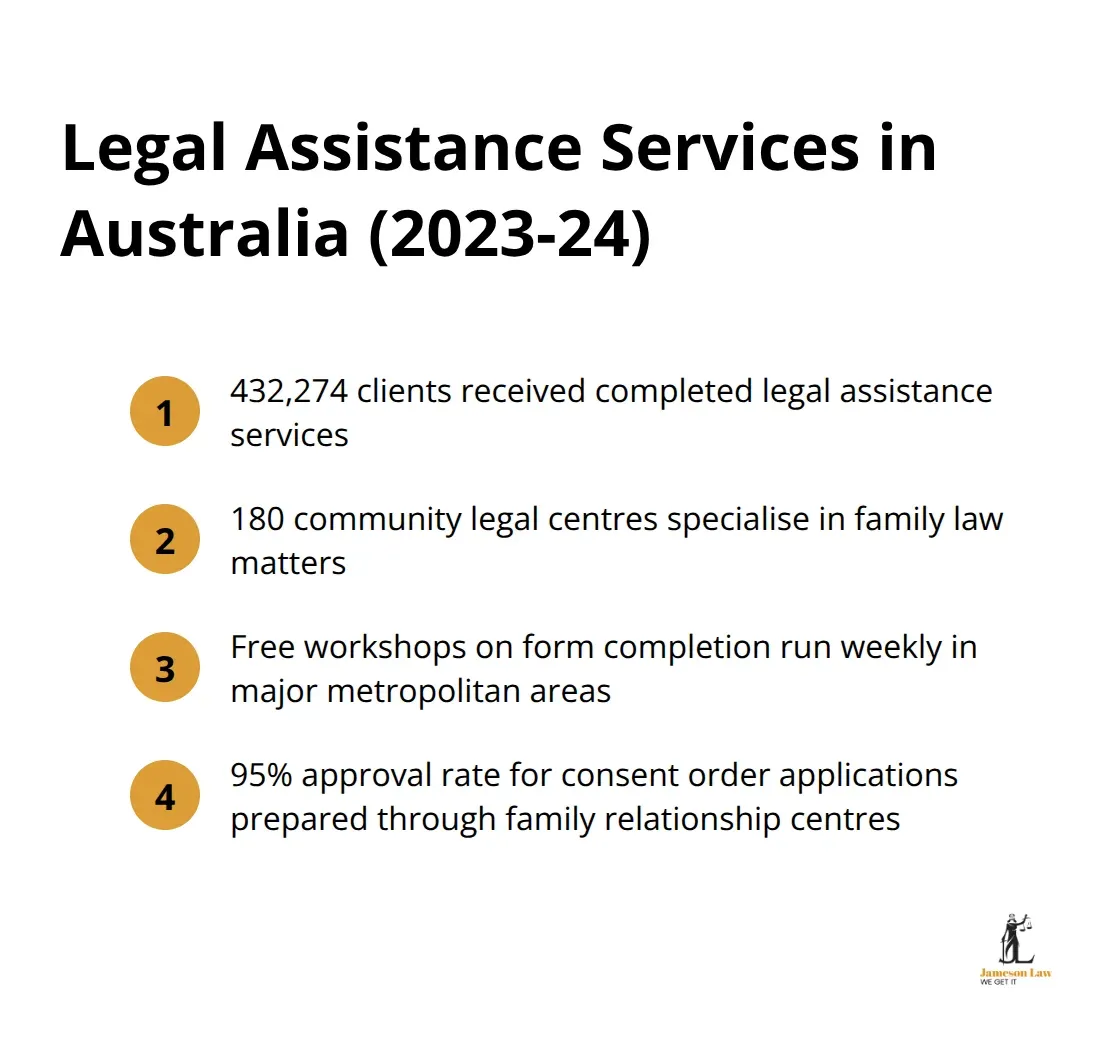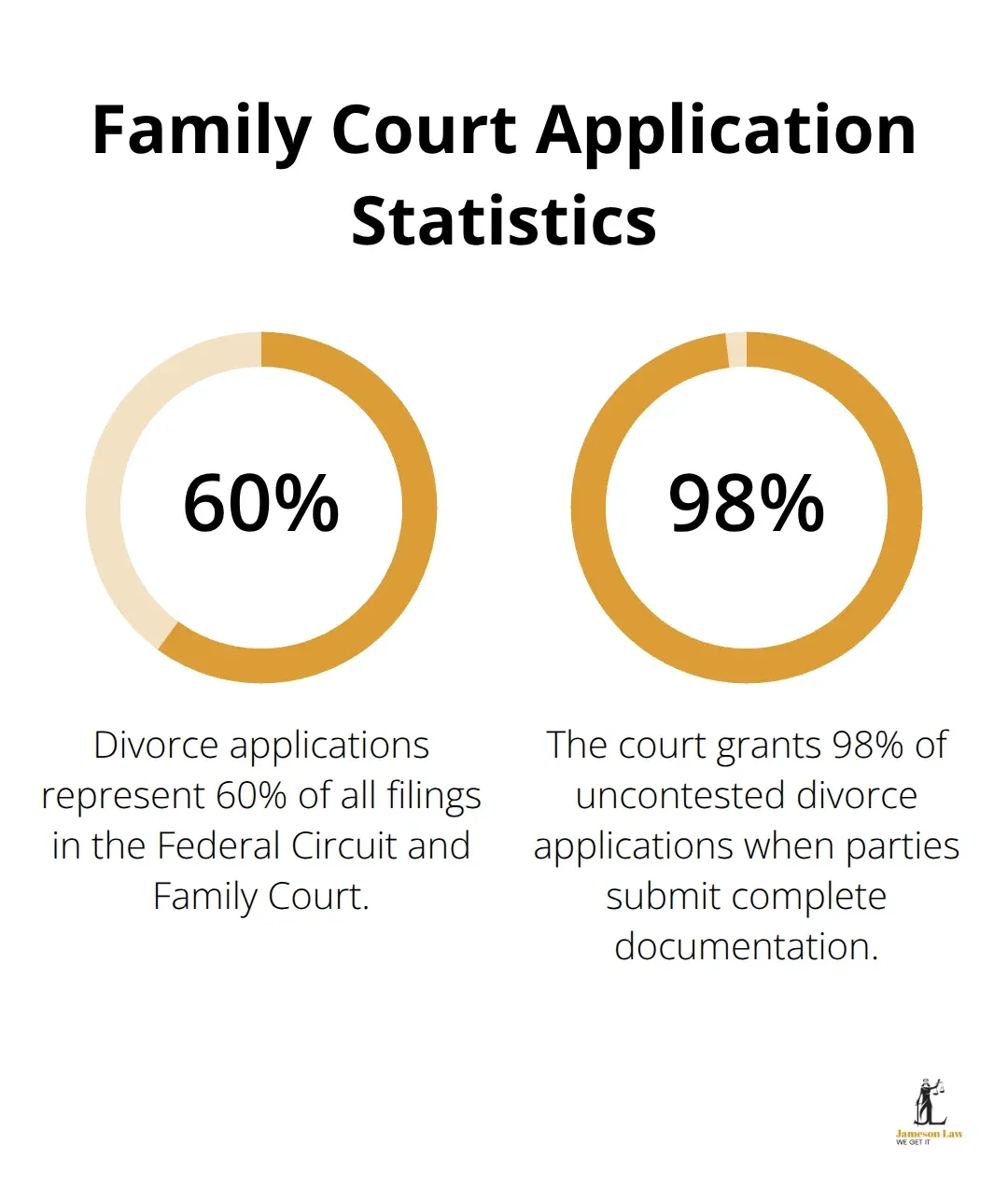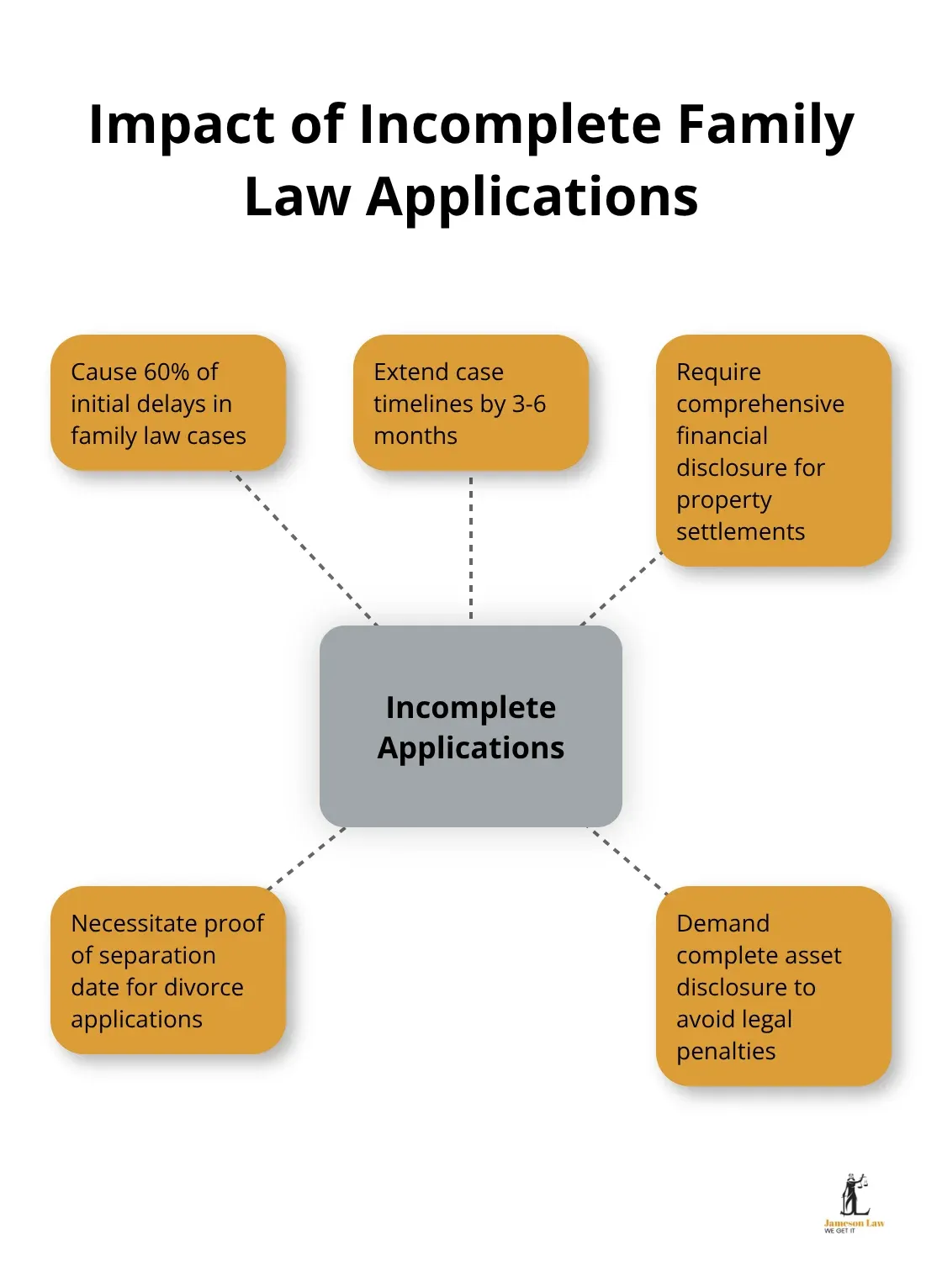Navigating Australia’s family law system requires completing the right paperwork at the right time. Missing forms or filling them out incorrectly can delay your case by months.
We at Jameson Law see families struggle with family law forms every day. This guide shows you exactly where to find these documents and how to complete them without costly mistakes.
Where to Find Family Law Forms in Australia
The Federal Circuit and Family Court of Australia website serves as your primary source for official family law forms. This court finalised 1,450 applications, making it the central hub for all required documentation. The website provides downloadable PDF forms for divorce applications, parenting arrangements, property settlements, and financial agreements. Most forms come with step-by-step completion guides that reduce processing delays by up to 30% compared to incorrectly submitted paperwork.
State Legal Aid Offices Provide Free Access
Legal Aid NSW and other state legal aid offices offer free access to family law forms plus completion assistance for eligible applicants. In 2023–24, 432,274 clients received completed legal assistance services from Legal Aid Commissions and Community Legal Centres across Australia. Legal aid offices provide self-help kits that include all necessary forms for common family law issues. Income thresholds determine eligibility (with most offices serving individuals earning under $45,000 annually). Staff members review completed forms before submission, catching errors that typically cause 40% of self-represented applications to face delays. You can check eligibility here: Applying for Legal Aid.

Community Legal Centres Offer Local Support
Community legal centres and family relationship centres provide localised form assistance with face-to-face guidance. Australia has 180 community legal centres that specialise in family law matters. These centres offer free workshops on form completion, with sessions that run weekly in major metropolitan areas. Family relationship centres focus specifically on parenting arrangements and mediation services. Their staff help families complete consent order applications, which have a 95% approval rate when properly prepared through these centres.
Once you know where to find these forms, you need to understand which specific documents apply to your situation and how each type serves different legal purposes.
Understanding Different Types of Family Law Forms
Family law forms fall into three distinct categories that address different aspects of relationship breakdowns. The Federal Circuit and Family Court processed applications with the majority being applications in a proceeding, with divorce applications representing 60% of all filings. Application for Divorce forms require only basic information about your marriage and separation dates, which makes them the simplest family law documents to complete. These forms cost $990 to file, though fee reductions apply for those who earn under $22,140 annually. Joint applications reduce this fee to $1,430 for both parties combined.
Divorce and Separation Forms
Divorce applications handle the legal termination of marriage after 12 months of separation. The court requires proof of separation date, marriage certificate details, and arrangements for children under 18. Simple divorce cases without children take 4-6 months to process, while applications with children require additional parenting arrangements. The court grants 98% of uncontested divorce applications when parties submit complete documentation. Fee exemptions apply to applicants who receive Centrelink benefits or earn below the poverty line threshold. For process steps, see the court’s divorce info: Divorce.
Parenting and Child Support Documentation
Parenting arrangement forms become necessary when parents cannot agree on custody, contact schedules, or decision-making responsibilities. Application for Parenting Orders forms require detailed information about children’s current arrangements, proposed schedules, and any safety concerns. About one-fifth (20% or 9,600) of children who were subjects of substantiations were subsequently placed on an order within 12 months, but contested parenting matters took an average of 61 weeks to resolve. Child support assessment forms connect directly to Services Australia’s system, which calculated support for 1.2 million children in 2023-24. These forms automatically update when income changes occur (which reduces the need for manual variations by 45%).

Property Settlement and Financial Agreement Forms
Property settlement forms handle asset division, debt allocation, and spousal maintenance arrangements. Application for Property Orders requires comprehensive financial disclosure through Financial Statement forms, which must list every asset, liability, and income source. The court’s property settlement guidelines consider contributions, future needs, and relationship length when parties divide assets. Cases with property values exceeding $500,000 require professional valuations, while simpler matters under $200,000 often resolve through consent orders. Financial agreement forms allow couples to bypass court involvement entirely, though these documents require independent legal advice for each party before they become legally binding (which adds 2-4 weeks to the process). For valuation professionals, see the Australian Property Institute.
The complexity of these forms varies significantly, so you need to understand the specific completion requirements and common pitfalls that can delay your application.
How to Complete Family Law Forms Correctly
Proper preparation prevents delays from incomplete documentation. The Australian Institute of Family Studies reports that incomplete applications cause 60% of initial delays, which extends case timelines by 3-6 months. Start with your marriage certificate, birth certificates for all children, and financial records from the past 12 months. Property settlement forms require bank statements, superannuation details, and asset valuations. Divorce applications need proof of separation date through utility bills, lease agreements, or statutory declarations. Gather tax returns, payslips, and Centrelink statements before you start any financial disclosure forms. Courts request additional information when documents are missing, which adds 6-8 weeks to processing times.
Document Preparation Creates Success Foundation
Financial Statement forms demand complete asset disclosure that includes property values, vehicle registrations, and debt statements. The court requires professional valuations for properties worth over $500,000, while vehicles need current market assessments through RedBook or similar services. Superannuation statements must show current balances and contribution histories. Bank statements that cover 12 months reveal spending patterns that influence spousal maintenance calculations. Credit card statements, loan agreements, and mortgage documents complete the financial picture. Courts impose penalties for non-disclosure, with hidden assets leading to unfair settlements and potential legal penalties. Review the Family Law Rules 2021 for duty of disclosure requirements.

Form Completion Follows Strict Guidelines
Type all forms in 12-point font with single spacing and number pages consecutively. Affidavits cannot exceed 25 pages for Division 1 matters or 10 pages for Division 2 cases. Each paragraph should address one topic with clear headings that reference specific court orders sought. Sign every page in front of an authorised witness like a Justice of the Peace or solicitor. Attach documents as numbered annexures with witness signatures on each attachment. Courts automatically reject handwritten applications and forms with missing witness details. The most common errors include incorrect case numbers, missing signatures, and outdated form versions (which cause automatic rejections). Download forms directly from the court website to avoid superseded versions. For affidavit tips, see Affidavits.
Final Thoughts
Family law forms demand systematic preparation and precise attention to detail. Access official forms through the Federal Circuit and Family Court website, then collect all required documentation before you start completion. Follow format guidelines exactly and submit forms with proper witness signatures to avoid automatic rejections that delay cases by months.
Professional legal assistance becomes necessary when you deal with complex property settlements, contested parenting arrangements, or cases that involve family violence. We at Jameson Law provide expert family law services that help families complete documentation correctly and achieve optimal outcomes. Self-representation works for straightforward divorce applications, but contested matters benefit from professional guidance that prevents costly mistakes.
Legal Aid offices, community legal centres, and family relationship centres across Australia offer continued support. These resources provide free workshops, form completion assistance, and mediation services that resolve disputes without lengthy court proceedings (which saves both time and money). Keep all family law forms current by downloading the latest versions directly from official court websites, as outdated documents face automatic rejection.













